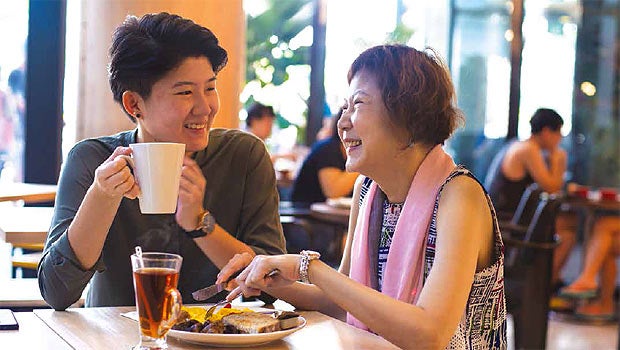
Ms Maple Lai donated her liver to her mum, Mdm Ong Hueh Min, who is now on the road to recovery
She never watched her diet and enjoyed the occasional drink. So when Maple Lai put her hand up to be a liver donor for her mother, she seemed an unlikely choice.
Her mother, Mdm Ong Hueh Min, 56, had suffered from Primary Biliary Cirrhosis for 16 years. The autoimmune disease of the liver progressively destroys the small bile ducts of the liver and eventually leads to cirrhosis.
In 2015, Mdm Ong’s condition worsened – she was severely jaundiced, had extreme water retention, and was constantly tired and breathless. She was given six months to live and advised that a liver transplant was her only hope.
Maple and her younger sister Charmaine immediately stepped forward as living donors. After five months of tests and evaluation, Maple’s liver was found to be more compatible because of its size, shape and condition.
The 25-year-old wealth manager said she was surprised, because Charmaine had always been the healthier of the two sisters. “It’s pretty ironic,” Maple quips. “My sister watches what she eats and always drinks plain water but her liver was found to be on the fatty side.”
"Liver transplant patients have complex needs. With the diverse expertise of the multidisciplinary transplant team, it ensures that patients are given timely, holistic care and better rehabilitation."
– Assoc Prof Prema Raj, Head of the SingHealth Duke-NUS Liver Transplant Centre
In Singapore, a close relative, a spouse or child, a friend or even an altruistic donor who has no relation to the patient can be a living donor. An altruistic donation means the donor should not gain anything from it.
Despite their willingness, Mdm Ong was very hesitant about having her daughters donate and opted to be placed on the waiting list for a liver from a deceased donor instead.
“I didn’t want my daughters to have any surgery or scars,” she explained. “Maple has thalassemia and also had epileptic fits when she was young. I was worried about her health”. However, her daughters dismissed her concerns.
Mdm Ong is one of the first patients of the SingHealth Duke-NUS Liver Transplant Centre, a SingHealth Duke-NUS Disease Centre, which was set up last year. While tests were being carried out to determine organ compatibility, both mother and daughter met up with the Transplant Ethics Committee as well as the liver transplant team, consisting of doctors, medical social workers, psychiatrists and transplant coordinators who prepared them, not only physically but also psychologically and emotionally for what would lie ahead.
The transplant coordinators, in particular, made a great impact. They were caring and supportive, always replying promptly to their texts and questions with detailed answers.
A session with the liver transplant support group also helped to relieve Mdm Ong’s worries.
“I met a young woman who donated part of her liver to her father. She shared her experience and seemed so healthy and happy,” recounted Mdm Ong with a smile. “I asked her how she felt about her surgical scar, and she said ‘it doesn’t matter!”
Mdm Ong’s surgery was conducted in March this year and she was back at work as an accounting manager three months later.
“We knew there were risks, but at least we know we have given our best for mum. It was really the best gift I could have given her.”
- Ms Maple Lai
“Liver transplant patients have complex needs. The diverse expertise of the multidisciplinary transplant team ensures that patients are given timely, holistic care and better rehabilitation,” said Associate Professor Prema Raj, Head of the SingHealth Duke-NUS Liver Transplant Centre.
The Centre brings together a multidisciplinary team comprising specialists from Singapore General Hospital, National Cancer Centre Singapore and KK Women’s and Children’s Hospital, who bring expertise in General Surgery/ Hepato-Pancreato-Biliary Surgery, Gastroenterology and Hepatology, as well as allied health professionals including medical social workers, dietitians and pharmacists.
Assoc Prof Raj added, “Previously, each profession would focus on their specialty but now the Liver Transplant Centre integrates the care that patients receive.”
In the meantime, Mdm Ong is adjusting to life after transplant. While she is getting used to the medication and side effects, she no longer feels tired and breathless all the time. Once an active person who regularly attended fitness classes, she looks forward to being given the go ahead by her doctors to start exercising again.
Post-transplant, Maple’s liver has grown back to its full size but she is taking it easy for now, watching her diet as well as her mother’s.
Durian has been Mdm Ong’s hardest habit to kick, while Maple has not touched a drop of alcohol since the surgery. She has no regrets about the surgery, even calling the keloids on her abdomen her “battle scars”. “We knew there were risks, but at least we know we have given our best for mum. It was really the best gift I could have given her.”
To those who are contemplating a living donor transplant, Mdm Ong says encouragingly: “If you love your family, let them support you.”













 Get it on Google Play
Get it on Google Play